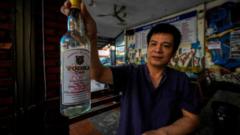Five tourists have died in Laos due to suspected methanol poisoning linked to unsafe drinking practices prevalent in the area. Despite foreign governments issuing warnings about alcohol consumption, the dangers associated with methanol remain largely unknown to many travelers. The crisis reflects broader issues surrounding the lack of regulation and education in the alcohol industry across the region.
Tragic Methanol Poisonings in Laos Spotlight South-East Asia's Bootleg Alcohol Crisis

Tragic Methanol Poisonings in Laos Spotlight South-East Asia's Bootleg Alcohol Crisis
Recent deaths in Laos from suspected methanol poisoning underline the ongoing threat of tainted alcohol in South-East Asia, particularly in impoverished regions.
In a tragic incident reflecting an ongoing public health crisis, five tourists have died in the popular holiday town of Vang Vieng, Laos, due to suspected methanol poisoning linked to contaminated drinks. The victims include nationals from the UK, Australia, the US, and Denmark, with another Australian woman currently in critical condition. This recent spate of deaths highlights the longstanding issue of methanol poisoning across South-East Asia, particularly in the poorer Mekong River countries.
Methanol is a toxic form of alcohol commonly found in industrial products, and its presence in bootleg drinks in tourist hotspots like Laos has repeatedly led to fatal outcomes. Unfortunately, methanol is difficult to detect as it is both colourless and odorless, causing symptoms to often appear several hours after consumption. Victims may initially experience nausea and abdominal pain, worsening to severe respiratory issues if not treated promptly.
According to research from Médecins Sans Frontières (MSF), South-East Asia has the highest rate of methanol poisoning incidents globally, with much of the problem rooted in lower-income countries such as Laos, Cambodia, and Indonesia. Illegal and unregulated production of alcohol, especially bootleg liquors, has proliferated in these regions due to limited law enforcement and regulatory oversight.
In Vang Vieng—part of a trail popular with backpackers—the local economy heavily relies on tourism, creating an environment where substandard alcohol production can thrive. Observers have noted that some producers substitute methanol for ethanol in crafting counterfeit beverages due to its lower cost. A diplomat in the region emphasized the role of poor production practices and lack of education in contributing to this ongoing crisis.
Despite existing knowledge among tourism operators about the dangers of consuming unofficial alcohol, further awareness and a high-profile campaign to educate tourists seem urgently needed. Some governments have begun updating their guidance on alcohol safety in the area in response to the recent fatalities. However, the efficacy of these measures remains uncertain, as tourists cannot reasonably verify the source of every drink they consume.
Advocates like Colin Ahearn, who runs a Facebook page dedicated to warning travelers about the risks of drinking spirits in destinations like Bali, underscore the necessity of proactive measures to mitigate risks. Nevertheless, discerning travelers may find it increasingly difficult to navigate alcohol safety without resorting to abstaining altogether during their visits.
As the recent report of methanol-related deaths reverberates in the global media, it brings renewed scrutiny of the consequences of poverty and neglect in alcohol production standards in some of South-East Asia's most frequented tourist locations.






















